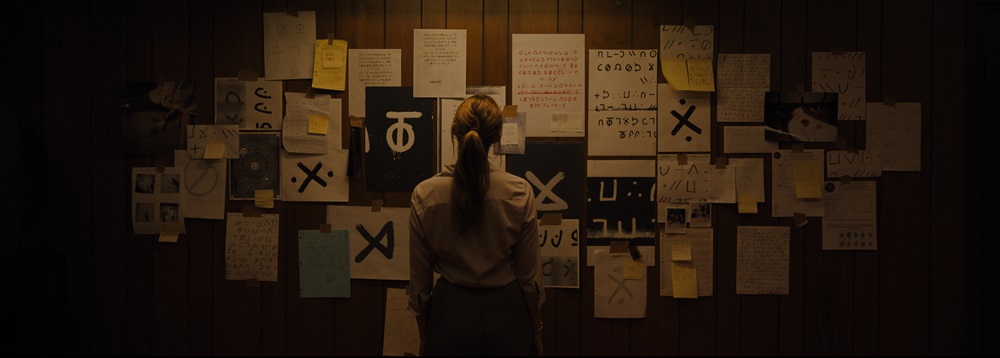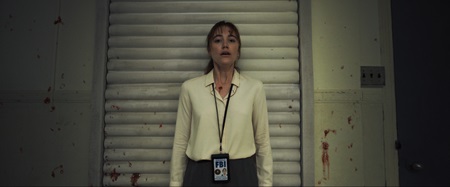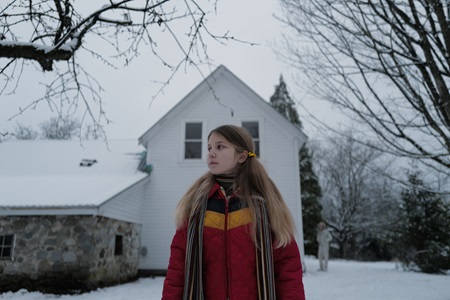
Bleak Longlegs Sees the Monster Lurking Within
Osgood Perkins doesn’t make things easy for an audience. His previous shockers The Blackcoat’s Daughter, I Am the Pretty Thing That Lives in the House, and Gretel & Hansel appeared to be straightforward thrillers of one sort or another: vaguely supernatural, dabbling in fantasy, but still revolving around tales of possession, ghosts, and fairy tale heroes that horror fans are already intimately familiar with. Yet with Perkins, all that familiarity is an illusion.
His films dig deeply into the human psyche, asking tough questions about who we think we are. As much as Perkins refuses to pull his punches, he also finds humor in the strangest of narrative places. Most hypnotically of all, he lets events play out to a methodical drumbeat that rarely (if ever) picks up speed, even during the climax.
The same goes for Longlegs. This is Perkins at his best and most uncompromising. While his new, psychologically crafty offering initially appears to be an unsettling serial killer piece reminiscent of classics like The Silence of Lambs and Se7en, the reality is altogether different. Breaking convention wherever possible and filled with unnerving ephemeral flashbacks that may be nothing but a pack of lies (or cold-hearted, utterly abhorrent truths as discovered by a mentally scarred victim who’s had the past brutally ripped away from them by a demonic sociopath), there’s little here that could be labeled as conventional.
This is fine by me. Perkins twists the knife in elegantly troubling ways. There were multiple instances where I knew exactly what was about to happen, and I was still jolted out of my seat as if I’d just felt an electrical shock. The director used my own knowledge of genre convention against me, and it is clear that Perkins wants to toy with this film’s viewers the same way his clever, brutally pitiless serial killer antagonist treats their victims.
Set in the early 1990s somewhere in a perpetually overcast Oregon, the story begins with rookie FBI agent Lee Harker (Maika Monroe) out in the field on her first assignment which leads to the arrest of a violent fugitive. She then graduates to the big leagues when the well-respected Agent Carter (Blair Underwood) puts her on his task force. He’s after a villain known only as “Longlegs,” an unstoppable menace who has been murdering entire families for nearly 30 years.
As awful as that is, it’s nothing to how Longlegs is realizing these massacres. Somehow, someway, the killer is convincing a member of each family (usually the father) to do it for them. Axe, knife, gun—the weapon does not matter. The only thing connecting all the victims is that in each family there is a child who will turn 9 on the 14th of the month. Carter believes Harker’s bordering-on-psychic instincts could be the key to breaking a case that up until now has produced precious few leads.
Perkins has layered his screenplay with precision, and no detail is overlooked. Clues to what is going on and why can be found in every frame, and cinematographer Andres Arochi utilizes multiple aspect ratios and masterful lighting techniques to generate a bone-chillingly disquieting visual ambience. Character motivations are rarely what they appear to be, and the true adversary isn’t so much the literal psychopath Harker and Carter are hunting, but is instead the evil that corruptibly lurks inside of the human soul and insidiously waits to seize control.
There is a bizzarro wildcard in this deck and, surprising no one, his name is Nicolas Cage. Cage plays Longlegs, and I am not revealing any of the plot’s secrets by stating that. This is the Academy Award winner in full wild-man mode. His performance is a whack-a-do whiplash of venal eccentricities, all of it slathered in grotesque, rubbery facial prosthetics (kudos to concept artist Keith Lau, special makeup effects artist Harlow MacFarlane, and their entire talented team) that help Cage achieve a level of theatricality that would almost be vaudevillian if it wasn’t so disturbingly biblical.
As laudable as all that may be, there is an aspect to this performance that, at least initially, hit a raw nerve with me. When Longlegs is introduced during a brief prologue, Cage gives off a distinctly effeminate vibe derived from his vocal inflections, the makeup design, and costume designer Mica Kayde’s flowing, wispy clothes. I was worried Perkins was about to unintentionally feed into some nasty Trans stereotypes far more egregious than any of the ones found in The Silence of the Lambs. While this proves not to be the case, I can easily guess that a sizable number of viewers will disagree with me on that point.
I can’t speak too much more on this subject, at least not in this review, as that would mean revealing many of the film’s darker secrets. Suffice it to say, Perkins is not delivering a Trans commentary. He’s more interested in diving headfirst into the nastier recesses of religious fundamentalism, familial dysfunction, and societal perceptions of gender norms.
It is in the supposedly civilized corners of rural and suburban polite society where the director sees the true monsters. With Longlegs, Perkins has no problem whatsoever in smothering the screen in literal and figurative blood and guts. In Perkins’s world no one, no matter how pure and innocent, can be redeemed, and true Hell is believing life (and, by insinuation, the afterlife) will offer up anything to the contrary. If that thought isn’t terrifying, what is?
– Review reprinted courtesy of the SGN in Seattle
Film Rating: 3½ (out of 4)







